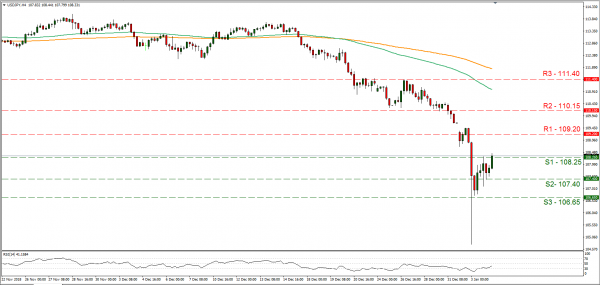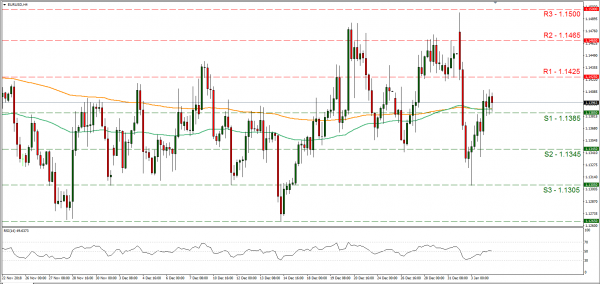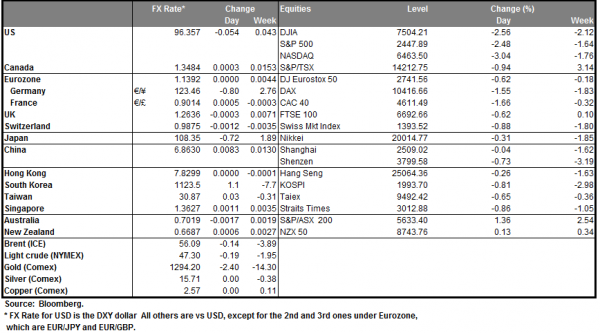Nervous markets are expected to focus on the release of the US employment report for December, today at 13:30 (GMT) for further direction. After the “flash crash” during the Asian session yesterday and the weak US Mfg PMI for December the bearish mood surrounding the USD strengthens. Analysts point out that the markets seem to be pricing in, no rate hikes by the Fed in 2019 and a possible rate cut in 2020. Also it should be noted, that Dallas Fed President Kaplan in an interview yesterday at Bloomberg, stated that the bank should allow for some time without action until some issues are resolved. The US employment report is expected to show an increase in the NFP figure raising it to 177k if compared to prior reading of 155k, average earnings ticking down to +3.0% yoy vs. prior reading of +3.1% yoy and an unchanged low unemployment rate at 3.7%. Should the market get more confident about a possible tightening of the US labour market by the data we could see the USD getting some support, while should the market perceive the data release as a threat to inflationary pressures and the Fed’s rate hike path we could see the USD weakening. EUR/USD strengthened yesterday, clearly breaking the 1.1385 (S1) resistance level (now turned to support). We see the case for the pair to be sensitive to the release of the US Employment report for December, Fed Chairman Powell’s speech as well as the release of the preliminary HICP rate of the Eurozone for December. Should the pair continue to rise, we could see it breaking 1.1425 (R1) resistance line and aim for the 1.1465 (R2) resistance hurdle. Should the pair on the other hand, come under the market’s selling interest, we could see it breaking the 1.1385 (S1) support line and aim for the 1.1345 (S2) support barrier.
US and China to hold trade talks
China and the US are expected to hold trade talks at a vice-ministerial level on the 7th and 8th of January in Beijing according to media. We do not see the case for a final resolution of the two countries differences to surface right now, however we could be seeing negotiations of substance. Weak financial data earlier this week could be signalling that both economies show signs of losing momentum, hence there might be more leverage for the two sides to reach an agreement or mark some progress. Analysts point out that the main issue remains whether the Chinese side will yield to key US demands and note a March deadline for a resolution or else the US may proceed with harsher tariffs. USD/JPY rose during today’s Asian session, breaking the 108.25 (S1) resistance line (now turned to support). We see the case for the pair to be sensitive regarding the release of the US employment report for December as well as any further headlines regarding the US-Sino trade talks. Should the bulls dictate the pair’s direction we could see it breaking the 109.20 (R1) resistance level, while if the bears take over, we could see the pair breaking the 108.25 (S1) support line and aim if not break the 107.40 (S2) support barrier.
In today’s other economic highlights:
In today’s European session, we get UK’s Nationwide HPI rate, France’s preliminary CPI (EU Normalised) rate, Germany’s unemployment data, Eurozone’s final Composite PMI, UK Services PMI and Eurozone’s [preliminary HICP rate all for December. In the American session, besides the release of the US Employment report for December, we get Canada’s employment data for December as well as the EIA crude oil inventories figure and the Baker Hughes oil rig count. Please note that Fed Chairman Jerome Powell, Atlanta Fed President Bostic and Richmond Fed President Barkin speak.
USD/JPY H4
Support: 108.25 (S1), 107.40 (S2), 106.65 (S3)
Resistance: 109.20 (R1), 110.15 (R2), 111.40 (R3)
EUR/USD H4
Support: 1.1385 (S1), 1.1345 (S2), 1.1305 (S3)
Resistance: 1.1425 (R1), 1.1465 (R2), 1.1500 (R3)
















